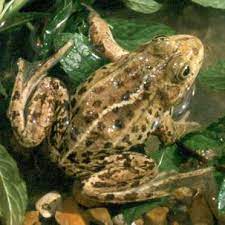The pool frog, scientifically known as Pelophylax lessonae, is a fascinating amphibian found primarily in parts of Europe. Here’s a detailed overview of this species:
Key Features of Pool Frog
Physical Characteristics
- Size: Adults typically measure around 3 to 4 inches (7.5 to 10 cm) in length.
- Coloration: They usually have a smooth, green or brown body with darker spots or stripes, which helps with camouflage in their aquatic habitats.
- Skin: Their skin is smooth and moist, facilitating respiration and hydration.
Habitat
- Geographic Range: Native to Europe, particularly in countries such as Sweden, Germany, and the UK. They are often found in lowland areas.
- Environment: Prefers shallow water bodies, including ponds, ditches, and marshes, with abundant vegetation for shelter and breeding.
Behavior
- Activity: Generally diurnal, active during the day. They are excellent swimmers and can often be seen basking on warm days.
- Diet: Carnivorous, feeding primarily on insects, larvae, and other small invertebrates.
Reproduction
- Breeding Season: Occurs in spring and early summer. Males attract females with their distinctive calls, which sound like a series of short, repetitive notes.
- Eggs: Females lay clusters of eggs in water, which hatch into tadpoles within a few days. Tadpoles undergo metamorphosis into juvenile frogs.
Conservation
- Threats: Habitat loss due to agricultural expansion, urban development, and pollution pose significant risks. Additionally, climate change can impact their breeding habitats.
- Status: The pool frog is classified as “Least Concern” by the IUCN, but local populations may be vulnerable, particularly in regions where habitats are fragmented.
Fun Facts
- Hybridization: The pool frog can hybridize with the marsh frog (Pelophylax ridibundus), leading to varied appearances in some populations.
- Indicator Species: They are considered indicators of environmental health, as their presence reflects the quality of aquatic ecosystems.
The pool frog plays a vital role in its ecosystem, contributing to the balance of food webs and serving as prey for various predators. Their adaptability and ecological importance make them an interesting subject for both conservationists and amphibian enthusiasts.
